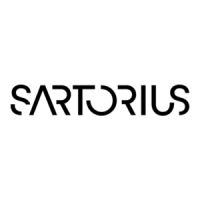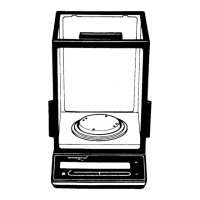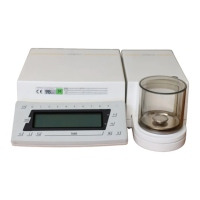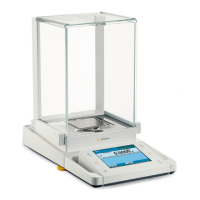Do you have a question about the Sartorius MC 210 S and is the answer not in the manual?
Describes the Sartorius Micro balances and their purpose.
Lists and identifies parts of the MC 210/410 series balances.
Lists and identifies parts of the MC 5/SC 2 series balances.
Details warranty coverage and registration procedures.
Specifies temperature and handling requirements for storage and transport.
Instructions on how to safely move the balance.
Specifies the necessary acclimatization period after relocation.
Outlines the linearization process required after moving the balance.
Steps to prepare the balance for legal metrology applications.
Lists supplied equipment for MC 210/410 series.
Lists supplied equipment for MC 5/SC 2 series.
Lists supplied equipment for MC 21S.
Specifies optimal environmental requirements for balance setup.
Details calibration and temperature needs for legal metrology use.
Step-by-step guide for assembling components for MC 210/410.
Instructions for positioning the external draft shield element.
Instructions for positioning the balance display unit.
Details component installation for the MC 21S model.
Steps for assembling components on MC 5/SC 2 balances.
Guide for installing and adjusting the draft shield.
Procedure for connecting the weighing cell and computing device.
Specifies voltage and adapter requirements for AC power connection.
Covers voltage settings and general safety measures for power connection.
Provides warnings and compliance information regarding RF interference.
Instructions for connecting external devices like printers or PCs.
Details how to level the balance using the integrated level indicator.
Addresses challenges and methods for weighing static-charged samples.
Provides techniques to reduce errors from magnetic samples.
Guidelines for proper sample preparation and handling during weighing.
Explains various codes and symbols displayed on the balance.
Instructions for powering the balance and initiating self-test.
Details the automatic electronic warmup sequence for specific models.
Explains methods for operating the draft shield door.
Describes the semi-automatic draft shield function with adjustable angles.
Explains how to open and close the draft shield manually.
Lists various methods to operate the motorized draft shield on MC 5/SC 2.
Guide to setting custom aperture angles for the draft shield.
How to numerically set the draft shield aperture.
Alternative method for manual draft shield control.
Step-by-step guide for basic weighing procedures.
Instructions for zeroing the balance with a container.
Describes the single-range weighing structure.
Explains the multi-interval weighing system.
Explains how IQ-Mode adjusts readability based on load.
How to toggle between different weight units.
Instructions to view balance model and serial number.
Explains the purpose and conditions for calibration.
Details the criteria for automatic isoCAL self-calibration.
Step-by-step guide for internal calibration using the f key.
Procedure for internal calibration using the tare key.
Details the process for external calibration with weights.
Instructions to unlock the menu access switch for verified balances.
How to perform external calibration by entering weight values.
Guide to running a calibration test with internal weights.
Step-by-step process for internal balance linearization.
Instructions for connecting a Sartorius Data Printer.
General guidance on connecting peripheral devices.
Explains how to use the below-balance weighing port.
Instructions for securing the balance with a locking device.
Lists common error codes and their solutions.
Advice on professional servicing to extend balance life.
Instructions for cleaning the exterior of the balance and draft shield.
Procedures for cleaning the internal weighing chamber.
Safety guidelines for the power supply and AC adapter.
Explains how to use the operating menu to customize balance settings.
Step-by-step guide for changing menu codes.
How to revert menu code settings to factory defaults.
Settings to adjust balance performance based on environmental factors.
Configuration options for standard and manual filling weighing modes.
Options to define the stability range for weight readouts.
Adjusts the delay for the stability symbol display.
Settings related to the taring operation.
Options to enable or disable the automatic zero tracking function.
How to configure the number of weighing ranges.
Options for selecting different weight units.
Configuration for weighing ranges on verified balances.
Options for weight units on verified balances.
Settings for display resolution and numeral blanking.
Explains the IQ-Mode display functionality.
Details PolyRange function's display modes and readability adjustments.
Configuration options for display modes on verified balances.
Settings to control access to external calibration.
Settings to control access to internal calibration.
Settings to control access to calibration tests.
Settings to control access to external linearization.
Options for multiple calibration procedures.
How to activate calibration functions using the f key.
Settings to control calibration access for verified balances.
Options for multiple calibration on verified balances.
Settings for isoCAL self-calibration and linearization.
How to activate CAL functions.
Settings for data output parameters.
How to start and stop automatic data output.
Setting intervals for automatic data output.
Feature for automatic taring after data output.
Options for including or excluding data ID codes.
Defines the function of the menu access switch.
Options to turn the acoustic signal on or off.
Settings to block or allow access to function keys.
Options to block numeric keys.
Configuration for balance power-on behavior.
Options for display backlighting.
How to define and use the fully automatic draft shield.
Settings for automatic draft shield operation.
Setting display accuracy with draft shield open or adjusted.
How to select the ISO/GLP printout/record mode.
Details the format of printouts for calibration/linearization.
Describes the format of data printouts.
Format for application program data printouts.
How to set the ID number for ISO/GLP records.
Procedure to set the balance date.
Procedure to set the balance time.
Overview of available application programs for Sartorius MC Balances.
How to use the c key to clear functions or reset programs.
Using the info key for data retrieval and transfer.
How to transmit numeric entries with ID codes.
Explains the formula used for air buoyancy correction.
How to enter and store sample density values.
Details the process for air buoyancy correction after density determination.
Steps to access the air density determination function.
Procedure for using the steel weight for air density calculation.
Procedure for using the aluminum weight for air density calculation.
Steps to store the determined air density and exit the function.
Explains the purpose and typical sequence of differential weighing.
Information on charging the internal battery for data retention.
Describes individual and consecutive weighing sequences.
Explains the combined weighing sequence.
How to enter and select memory location IDs.
Lists the types of data stored in memory locations.
Lists key combinations for various functions in the application.
Steps for performing tare weighing in individual mode.
Steps for performing the weighing-in process.
Steps for performing backweighing.
Lists menu codes for residue determination examples.
Procedure for tare weighing in combined mode.
Procedure for weighing-in in combined mode.
Steps for performing backweighing in combined mode.
Lists menu codes for dry weight determination examples.
Lists menu codes for coating mass measurement examples.
Shows how to display the first calculated value.
Shows how to display the second calculated value.
How to turn off the differential weighing and backweighing program.
Procedure to delete data from specific memory locations.
Procedure to clear all data from memory.
Settings for including date and time in records.
Settings for including tare and net weight in records.
Settings for including residue data in records.
Settings for including difference data in records.
How to set decimal places for percent readouts.
Overview of buoyancy and specific gravity bottle methods.
How to combine density program with other applications.
Configuration for immersion liquid parameters in buoyancy method.
Procedure for entering liquid density and expansion coefficient.
Mathematical formulas for density calculation using buoyancy.
Mathematical formulas for density calculation using specific gravity bottle.
Lists menu codes for the buoyancy method example.
Lists menu codes for specific gravity bottle method example.
How to set object density for diameter calculation.
Procedure for entering object length.
How to combine diameter determination with other applications.
Lists menu codes for diameter determination example.
How to store and use tare weights in memory.
Lists menu codes for displaying tare, net, and gross weights.
Lists menu codes for net total calculation example.
How to store reference values for percent weighing.
Lists menu codes for residue in percent determination example.
Steps to change the reference percentage value.
Options for adjusting reference percentage increments.
Settings for storing reference weights.
How to set decimal places for percent readouts.
How to set tolerance limits for checkweighing.
Lists menu codes for net weight checking example.
Settings for automatic data output in checkweighing.
How to activate data output port lines.
How to store reference sample weight for counting.
Procedure to update reference sample for improved counting accuracy.
Lists menu codes for counting small parts example.
Steps to change the reference sample quantity.
Options for reference sample quantity settings.
Settings for storing reference sample weight.
Lists error codes and their solutions for application programs.
Overview of connecting the balance to external devices.
Details interface types, standards, and transmission rates.
Describes the 16-character data output format.
Explains unit symbols used in data output.
Explains special codes used in data output.
Describes the 22-character data output format with ID codes.
Structure and syntax for control commands.
Commands using upper-case letters and special characters.
Commands to adjust balance to ambient conditions.
Commands using lower-case letters for functions.
Commands for controlling draft shield on specific models.
Commands for controlling draft shield on MC 5/SC 2 models.
Format for draft shield status output with ID codes.
Explains parameters like baud rate and handshake for data communication.
Information on software and hardware handshake protocols.
How to activate data output automatically or via command.
Settings for automatic data output.
Settings for baud rate.
Settings for parity options.
Settings for the number of stop bits.
Settings for handshake modes.
Pin assignments and functions for the female interface connector.
How to configure the universal remote-control switch.
Explains voltage levels for control outputs used in checkweighing.
Detailed pin assignments for the female interface connector.
Diagram showing cabling for RS-232 C/V24 interface.
Diagram showing cabling for RS-423/V10 interface.
Technical specifications for weighing capacity and readability.
Specifications for repeatability and linearity.
Details response times and ambient condition requirements.
Information on power, frequency, and built-in interface.
Lists supported application programs and standard features.
Technical specs for MC 21S capacity and readability.
Specs for MC 21S response time and operating environment.
Specs for MC 21S power, interface, and application programs.
Technical specs for MC 5/SC 2 capacity and readability.
Specs for MC 5/SC 2 response time and operating environment.
Specs for MC 5/SC 2 power, interface, and application programs.
Technical details for EC type-approved balances.
Details available data printers and remote displays.
Information on optional battery packs and foot switches.
Lists universal switches, weighing bowls, and scoops.
Details draft shield covers and balance tables.
Information on digital/analog converters and calibration sets.
Software for transferring data to PC applications.
Software for collecting and processing balance data.
Accessories for air density and density determination.
Accessories for handling static electricity.
Explains the CE mark and its significance for equipment.
Details EU directives concerning weighing instruments in legal metrology.
Describes the services included in a new balance installation package.
Lists EC type-approval certificates for Sartorius models.
Overview of balance key functions.
Basic steps for performing simple weighing.
Step-by-step guide for selecting and setting menu codes.
Setup task for adjusting the external draft shield.
Operational feature for adjusting draft shield aperture.
Steps for performing internal balance calibration.
Steps for performing external balance calibration.
Steps for performing internal balance linearization.
Lists menu codes for the EUREKA air buoyancy program.
Summary of essential menu codes for weighing modes.
Overview of tare parameter and auto zero configurations.
Summary of range settings and data output configurations.
Overview of ISO/GMP output and additional function settings.
Details the air density determination application program.
Lists available application programs and their keys.
Configuration for automatic output of parameters.
Configuration options for weighing sequences.
Settings for fully automatic draft shield operation.
How to reset all menu codes to factory defaults.
Describes the Sartorius Micro balances and their purpose.
Lists and identifies parts of the MC 210/410 series balances.
Lists and identifies parts of the MC 5/SC 2 series balances.
Details warranty coverage and registration procedures.
Specifies temperature and handling requirements for storage and transport.
Instructions on how to safely move the balance.
Specifies the necessary acclimatization period after relocation.
Outlines the linearization process required after moving the balance.
Steps to prepare the balance for legal metrology applications.
Lists supplied equipment for MC 210/410 series.
Lists supplied equipment for MC 5/SC 2 series.
Lists supplied equipment for MC 21S.
Specifies optimal environmental requirements for balance setup.
Details calibration and temperature needs for legal metrology use.
Step-by-step guide for assembling components for MC 210/410.
Instructions for positioning the external draft shield element.
Instructions for positioning the balance display unit.
Details component installation for the MC 21S model.
Steps for assembling components on MC 5/SC 2 balances.
Guide for installing and adjusting the draft shield.
Procedure for connecting the weighing cell and computing device.
Specifies voltage and adapter requirements for AC power connection.
Covers voltage settings and general safety measures for power connection.
Provides warnings and compliance information regarding RF interference.
Instructions for connecting external devices like printers or PCs.
Details how to level the balance using the integrated level indicator.
Addresses challenges and methods for weighing static-charged samples.
Provides techniques to reduce errors from magnetic samples.
Guidelines for proper sample preparation and handling during weighing.
Explains various codes and symbols displayed on the balance.
Instructions for powering the balance and initiating self-test.
Details the automatic electronic warmup sequence for specific models.
Explains methods for operating the draft shield door.
Describes the semi-automatic draft shield function with adjustable angles.
Explains how to open and close the draft shield manually.
Lists various methods to operate the motorized draft shield on MC 5/SC 2.
Guide to setting custom aperture angles for the draft shield.
How to numerically set the draft shield aperture.
Alternative method for manual draft shield control.
Step-by-step guide for basic weighing procedures.
Instructions for zeroing the balance with a container.
Describes the single-range weighing structure.
Explains the multi-interval weighing system.
Explains how IQ-Mode adjusts readability based on load.
How to toggle between different weight units.
Instructions to view balance model and serial number.
Explains the purpose and conditions for calibration.
Details the criteria for automatic isoCAL self-calibration.
Step-by-step guide for internal calibration using the f key.
Procedure for internal calibration using the tare key.
Details the process for external calibration with weights.
Instructions to unlock the menu access switch for verified balances.
How to perform external calibration by entering weight values.
Guide to running a calibration test with internal weights.
Step-by-step process for internal balance linearization.
Instructions for connecting a Sartorius Data Printer.
General guidance on connecting peripheral devices.
Explains how to use the below-balance weighing port.
Instructions for securing the balance with a locking device.
Lists common error codes and their solutions.
Advice on professional servicing to extend balance life.
Instructions for cleaning the exterior of the balance and draft shield.
Procedures for cleaning the internal weighing chamber.
Safety guidelines for the power supply and AC adapter.
Explains how to use the operating menu to customize balance settings.
Step-by-step guide for changing menu codes.
How to revert menu code settings to factory defaults.
Settings to adjust balance performance based on environmental factors.
Configuration options for standard and manual filling weighing modes.
Options to define the stability range for weight readouts.
Adjusts the delay for the stability symbol display.
Settings related to the taring operation.
Options to enable or disable the automatic zero tracking function.
How to configure the number of weighing ranges.
Options for selecting different weight units.
Configuration for weighing ranges on verified balances.
Options for weight units on verified balances.
Settings for display resolution and numeral blanking.
Explains the IQ-Mode display functionality.
Details PolyRange function's display modes and readability adjustments.
Configuration options for display modes on verified balances.
Settings to control access to external calibration.
Settings to control access to internal calibration.
Settings to control access to calibration tests.
Settings to control access to external linearization.
Options for multiple calibration procedures.
How to activate calibration functions using the f key.
Settings to control calibration access for verified balances.
Options for multiple calibration on verified balances.
Settings for isoCAL self-calibration and linearization.
How to activate CAL functions.
Settings for data output parameters.
How to start and stop automatic data output.
Setting intervals for automatic data output.
Feature for automatic taring after data output.
Options for including or excluding data ID codes.
Defines the function of the menu access switch.
Options to turn the acoustic signal on or off.
Settings to block or allow access to function keys.
Options to block numeric keys.
Configuration for balance power-on behavior.
Options for display backlighting.
How to define and use the fully automatic draft shield.
Settings for automatic draft shield operation.
Setting display accuracy with draft shield open or adjusted.
How to select the ISO/GLP printout/record mode.
Details the format of printouts for calibration/linearization.
Describes the format of data printouts.
Format for application program data printouts.
How to set the ID number for ISO/GLP records.
Procedure to set the balance date.
Procedure to set the balance time.
Overview of available application programs for Sartorius MC Balances.
How to use the c key to clear functions or reset programs.
Using the info key for data retrieval and transfer.
How to transmit numeric entries with ID codes.
Explains the formula used for air buoyancy correction.
How to enter and store sample density values.
Details the process for air buoyancy correction after density determination.
Steps to access the air density determination function.
Procedure for using the steel weight for air density calculation.
Procedure for using the aluminum weight for air density calculation.
Steps to store the determined air density and exit the function.
Explains the purpose and typical sequence of differential weighing.
Information on charging the internal battery for data retention.
Describes individual and consecutive weighing sequences.
Explains the combined weighing sequence.
How to enter and select memory location IDs.
Lists the types of data stored in memory locations.
Lists key combinations for various functions in the application.
Steps for performing tare weighing in individual mode.
Steps for performing the weighing-in process.
Steps for performing backweighing.
Lists menu codes for residue determination examples.
Procedure for tare weighing in combined mode.
Procedure for weighing-in in combined mode.
Steps for performing backweighing in combined mode.
Lists menu codes for dry weight determination examples.
Lists menu codes for coating mass measurement examples.
Shows how to display the first calculated value.
Shows how to display the second calculated value.
How to turn off the differential weighing and backweighing program.
Procedure to delete data from specific memory locations.
Procedure to clear all data from memory.
Settings for including date and time in records.
Settings for including tare and net weight in records.
Settings for including residue data in records.
Settings for including difference data in records.
How to set decimal places for percent readouts.
Overview of buoyancy and specific gravity bottle methods.
How to combine density program with other applications.
Configuration for immersion liquid parameters in buoyancy method.
Procedure for entering liquid density and expansion coefficient.
Mathematical formulas for density calculation using buoyancy.
Mathematical formulas for density calculation using specific gravity bottle.
Lists menu codes for the buoyancy method example.
Lists menu codes for specific gravity bottle method example.
How to set object density for diameter calculation.
Procedure for entering object length.
How to combine diameter determination with other applications.
Lists menu codes for diameter determination example.
How to store and use tare weights in memory.
Lists menu codes for displaying tare, net, and gross weights.
Lists menu codes for net total calculation example.
How to store reference values for percent weighing.
Lists menu codes for residue in percent determination example.
Steps to change the reference percentage value.
Options for adjusting reference percentage increments.
Settings for storing reference weights.
How to set decimal places for percent readouts.
How to set tolerance limits for checkweighing.
Lists menu codes for net weight checking example.
Settings for automatic data output in checkweighing.
How to activate data output port lines.
How to store reference sample weight for counting.
Procedure to update reference sample for improved counting accuracy.
Lists menu codes for counting small parts example.
Steps to change the reference sample quantity.
Options for reference sample quantity settings.
Settings for storing reference sample weight.
Lists error codes and their solutions for application programs.
Overview of connecting the balance to external devices.
Details interface types, standards, and transmission rates.
Describes the 16-character data output format.
Explains unit symbols used in data output.
Explains special codes used in data output.
Describes the 22-character data output format with ID codes.
Structure and syntax for control commands.
Commands using upper-case letters and special characters.
Commands to adjust balance to ambient conditions.
Commands using lower-case letters for functions.
Commands for controlling draft shield on specific models.
Commands for controlling draft shield on MC 5/SC 2 models.
Format for draft shield status output with ID codes.
Explains parameters like baud rate and handshake for data communication.
Information on software and hardware handshake protocols.
How to activate data output automatically or via command.
Settings for automatic data output.
Settings for baud rate.
Settings for parity options.
Settings for the number of stop bits.
Settings for handshake modes.
Pin assignments and functions for the female interface connector.
How to configure the universal remote-control switch.
Explains voltage levels for control outputs used in checkweighing.
Detailed pin assignments for the female interface connector.
Diagram showing cabling for RS-232 C/V24 interface.
Diagram showing cabling for RS-423/V10 interface.
Technical specifications for weighing capacity and readability.
Specifications for repeatability and linearity.
Details response times and ambient condition requirements.
Information on power, frequency, and built-in interface.
Lists supported application programs and standard features.
Technical specs for MC 21S capacity and readability.
Specs for MC 21S response time and operating environment.
Specs for MC 21S power, interface, and application programs.
Technical specs for MC 5/SC 2 capacity and readability.
Specs for MC 5/SC 2 response time and operating environment.
Specs for MC 5/SC 2 power, interface, and application programs.
Technical details for EC type-approved balances.
Details available data printers and remote displays.
Information on optional battery packs and foot switches.
Lists universal switches, weighing bowls, and scoops.
Details draft shield covers and balance tables.
Information on digital/analog converters and calibration sets.
Software for transferring data to PC applications.
Software for collecting and processing balance data.
Accessories for air density and density determination.
Accessories for handling static electricity.
Explains the CE mark and its significance for equipment.
Details EU directives concerning weighing instruments in legal metrology.
Describes the services included in a new balance installation package.
Lists EC type-approval certificates for Sartorius models.
Overview of balance key functions.
Basic steps for performing simple weighing.
Step-by-step guide for selecting and setting menu codes.
Setup task for adjusting the external draft shield.
Operational feature for adjusting draft shield aperture.
Steps for performing internal balance calibration.
Steps for performing external balance calibration.
Steps for performing internal balance linearization.
Lists menu codes for the EUREKA air buoyancy program.
Summary of essential menu codes for weighing modes.
Overview of tare parameter and auto zero configurations.
Summary of range settings and data output configurations.
Overview of ISO/GMP output and additional function settings.
Details the air density determination application program.
Lists available application programs and their keys.
Configuration for automatic output of parameters.
Configuration options for weighing sequences.
Settings for fully automatic draft shield operation.
How to reset all menu codes to factory defaults.











